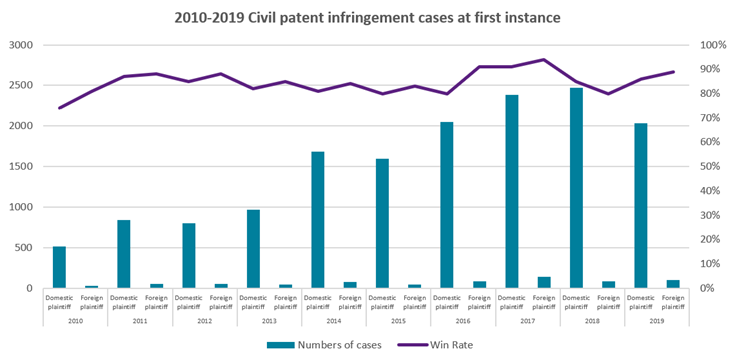A look into judicial remedies on patent infringement cases and suggested areas for improvement.
The Beijing Intellectual Property Court (“BIPC”) recently released a report on patent infringement cases tried by the BIPC between its establishment in November 2014 up to March 2020. The report examines the effectiveness of judicial remedies on patent infringement cases and suggests areas for improvement.
During this period, the BIPC received a total of 2,811 patent infringement cases and adjudicated 1,923 cases, with a completion rate of over 68%. 65.5% of the total cases received were settled or withdrawn, while 480 cases were closed by judgements, which accounted for 17% of the total cases. It is important to note that the data is not comprehensive as there are low closing rates for high technology cases, with trials being time consuming and laborious.
The report also indicates that there is a year-on-year increase on the number of cases received and closed, along with the emergence of new types of cases. The proportion of patent owners winning the case is comparatively high, and calculation of damages for the most part has been based on statutory damages. These trends are also supported by data retrieved from CIELA, our online tool for analysing Chinese IP administrative appeals and civil infringement proceedings.
According to the data from CIELA, the number of cases heard at first instance for both domestic and foreign plaintiffs has steadily increased from 2010 to 2019. The average win rate for domestic plaintiffs over the decade was 83%, while foreign plaintiffs enjoyed an average win rate of 86% in comparison (see below table).
 Source: CIELA
Source: CIELA
The report, however, said there remain areas for improvement:
- The PRC Patent Law provides that damages should be assessed in the following order, if possible: 1) patentee’s lost profits due to infringement; 2) infringer’s gains from infringement; 3) reasonable royalties; and 4) statutory damages. In practice, however, statutory damages has become the most common calculation method used by the BIPC, even though it ranks last in the order of application.
- The court tends to submit a general analysis when assessing damages, rather than conducting a thorough analysis. This will be partly due to the high evidence thresholds in Chinese courts.
- Cases are assigned randomly to different panels of judges. Related cases may be assigned to different panels, leading to ‘different judgments for the same case’.
The following measures were suggested to resolve the issues highlighted in the report:
- Amend the rules of evidence for patent infringements. Rules on the disclosure, preservation and obstruction of evidence for patent infringement cases should be properly applied and improved. This has been dealt with in many ways by the implementation of “Several Provisions of the Supreme People’s Court on Evidence for Civil Proceedings (New Evidence Rules)”, which came into effect on 1 May 2020.
- Parties should be free to choose the method for calculating damages. There are instances where parties have submitted evidence for the assessment of damages, but the court has overlooked them in favour of statutory damages. The court should instead use the other three methods to calculate damages if parties have submitted the evidence to do so and rely on statutory damages only as a method of last resort.
- Improve the application of statutory damages and explore discretionary mechanisms. Statutory damages should be applied by the court only if the parties agree to do so. Discretionary factors should be refined by the court so that its application can be more standardised and predictable. Discretionary compensation mechanisms that meet both patent law and market requirements should also be established so that the amount of damages matches the market value of the patent, and the amount contributed by the patent matches the profit resulting from the infringement.
Source:
- 北京知产法院关于专利侵权案件损害赔偿情况的调研报告, IPR Daily, http://www.iprdaily.cn/news_25948.html
- Many questions remain about patent litigation risk in China, IAM, https://www.iam-media.com/litigation/many-questions-remain-about-patent-litigation-risk-in-china
 Source: CIELA
Source: CIELA